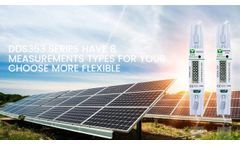Wind Power System Articles & Analysis
35 articles found
An export electricity meter is a device used to measure and record the output energy in a power system, usually used in solar power generation systems, wind power generation systems or other renewable energy generation systems. ...
But firm renewables enable us to deal with the intermittency of solutions like wind and solar by bolstering existing energy supply. They’re similar to energy storage systems, which are often touted as a solution to intermittent renewables because they capture excess energy for use at a later date, in that they both reduce imbalances between energy demand ...
Introducing the next generation of SimpliPhi Power’s industry-leading safe lithium ferro phosphate (LFP) battery – the PHI 3.8-M – now available in our sleek but tough signature white metal design. Instantly recognizable by the rugged, powder-coated steel housing, our updated PHI 3.8-M kilowatt-hour (kWh) battery is more durable, efficient, and capable of withstanding the ...
Germany's Siemens Gamesa will supply 11 of its 8 MW direct drive turbines while Norway's Kvaerner will design and build the substructures and lead onshore assembly, inshore marine operations and site connection. UK group JDR Cable Systems will supply the electrical cables and Norway's Subsea 7 will install the cables and connect up the wind facility to the oil ...
1.Introduction Living off the grid brings memories of a cabin deep in the woods or a hut in the mountains. But in essence, off grid solar system is basically home solar systems providing electricity to private premises and not necessarily in connection with the public grid. Living off the grid is a state of autonomy. It is a way to avoid all the complications that come with sharing electricity ...
Vortex is not the only business looking to develop new ideas and technology in the field of wind energy. Kite Power Systems, for example, is a U.K.-based business that wants to use kites to harness wind energy. ...
This paper presents the development and qualitative validation of a doubly-fed induction generator (DFIG) wind turbine model that is represented in terms of behaviour equations of each of the subsystems, mainly the turbine rotor, the drive train, the induction generator, the power converters and associated control systems and a protection ...
In this paper, data–driven system modelling, control, and fault detection technique for wind turbine systems are researched. ...
The impact of the wind generation on the power systems is no longer negligible if high penetration levels are going to be achieved. It is very important to boost the transfer capability of the transmission system while improving the utilisation of transmission assets to accommodate high penetration of wind ...
The efficiency of the wind power conversions systems can be greatly improved using an appropriate control algorithm. In this work, a robust control for variable speed wind power generation that incorporates a doubly feed induction generator is described. ...
This additional secondary winding of zigzag transformer facilitates to select the optimum voltage rating of the battery system at DC bus. The control algorithm of the controller is developed for bidirectional flow capability of the active power and reactive power control by which it controls the system voltage ...
In this study, the solar radiation and wind data pertaining to Bigadic region are analyzed to assess the performance of a hybrid Photovoltaic–Wind–Diesel–Battery energy system. ...
In this study, the solar radiation and wind data pertaining to Bigadic region are analyzed to assess the performance of a hybrid Photovoltaic-Wind-Diesel-Battery energy system. The average energy consumption of the system is about 20.33 kWh per day and 600 kWh per month, with a peak power demand of 2.4 kW. A 10 ...
In this paper, a new robust controller has been proposed for attaining the maximum safe instantaneous wind penetration. Particle swarm optimisation (PSO)-based algorithm has been developed to obtain the maximum safe instantaneous penetration by the optimisation of grid parameters. The developed algorithm has been tested on modified IEEE 14-bus system. The ...
Our main conclusion is that in the wind power case in The Netherlands, the knowledge cycles were not complete. For too long, science and technology were not connected well enough to society and market. The Danish wind power case shows initially separated development paths, but these gradually merged together, which resulted in a ...
This paper investigates the operation and control of multiple Distributed Generation (DG) systems interconnected to the utility in the form of microgrid. The developed model of the microgrid consists of microturbine generation system, converter-based DG system with stiff DC source, synchronous-generator-based DG system and ...
This paper presents a novel usage of 6/3-phase dual stator-winding induction generator (DWIG) with a static excitation power controller (SEC) as a wind power generator. ...
Hust says she is particularly eager to see how the tax credit affects manufacturing of advanced transmission, smart grid and energy storage products, since they may be key to integrating more wind power into the system. The DOE says the credit is available for:• Technologies that create energy from renewable resources (sun, wind, ...
In this paper, a methodology for sizing of hybrid photovoltaic-wind power generation (HPVWPG) system is described. The purpose of this methodology is to predict the PV-generator area, the capacity of the battery and the capacity of the wind generator in isolated (remote) areas, where the meteorological data (solar irradiation, ...
Currently, wind power faces heterogeneous conditions for market integration throughout Europe, given both differing wind power and power system characteristics as well as according regulatory frameworks. This paper discusses marketing options and assesses the influence of market rules on the ...








